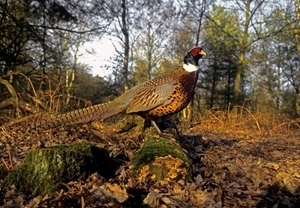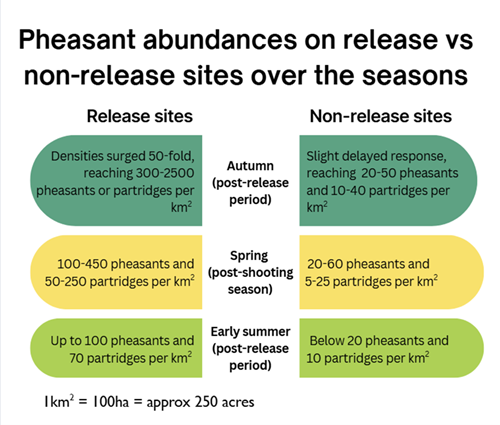Key points
- It is essential to continuously improve our understanding of the distribution of released gamebirds and their potential impact on the surrounding habitat.
- This study surveyed pheasant and partridge populations across ten gamebird release sites and eight non-release sites and provides estimates of densities at those sites.
- On release sites densities varied considerably through the seasons. Outside of the shooting season densities were 100-450 pheasants per km² in early spring and up to 100 pheasants per km² in early summer (one km² is 100 hectares or approximately 250 acres).
- On non-release areas, between 500m and 2km away from release sites, gamebird populations remained relatively stable and significantly lower than on release sites. There were 20-60 pheasants per km² in spring and less than 20 pheasants per km² in summer.
Background
 The release of common pheasants (Phasianus colchicus) and red-legged partridges (Alectoris rufa) for driven game shooting is widespread across the UK, particularly in southern and northeastern England. Each year, an estimated 35-46 million pheasants and 8-12 million partridges are released.
The release of common pheasants (Phasianus colchicus) and red-legged partridges (Alectoris rufa) for driven game shooting is widespread across the UK, particularly in southern and northeastern England. Each year, an estimated 35-46 million pheasants and 8-12 million partridges are released.
The release process is managed to ensure the birds’ health and limit predation. From pens strategically positioned in woodland habitats to dedicated feeding points and game crops, every measure is designed to keep the birds within the boundaries of the shoot areas.
Previous estimates published suggest that typically 90-95% of released gamebirds tend to stay within a 1km radius of their release sites but little is known about their densities across the wider landscape, particularly on non-release land.
The extent to which gamebirds stray beyond the release site into the wider countryside has implications not only for shoot managers but also for conservationists and landowners concerned about the potential ecological effects.
While gamebird releasing has been linked to enhanced habitats and improved predator control, it can also have negative effects on for example soils, ground flora and invertebrates. Research from the GWCT and others has shown that these effects are most pronounced at release sites, where birds are at their highest densities. However, there is still potential for impacts in other places where birds congregate.
Given these concerns, current licensing regulations require best practice and restrict releases within 500m of protected Special Areas of Conservation (SACs) and Special Protected Areas (SPAs).
What they did
This study monitored gamebird patterns and densities over 19 months at 18 sites in central southern England, spanning Dorset, Hampshire and Wiltshire. Researchers surveyed ten professionally managed release areas, each covering at least 5km² and hosting 10,000+ gamebirds, alongside eight non-release sites located within 2km of one or more release sites.
Surveys were conducted ever three weeks, with birds observed from walked transects of 3km at each site. A vehicle-based density count was also undertaken in March and April to calculate an adjustment factor that allowed researchers to estimate gamebird densities throughout the year from the walking transect surveys. This combination provided a broad insight into seasonal changes in gamebird densities at release sites and in nearby non-release areas.
The analysis did not incorporate seasonal variations in detectability and the paper acknowledges reduced visibility, due to dense vegetation, might affect numbers seen in summer before crops were harvested. General Linear Models were applied to examine bird densities in relation to site type and seasonal trends, while taking account of possible weather impacts. The survey programme as a whole was scheduled to cover two seasonal gamebird releases.
What they found
The study showed that, as expected, bird densities fluctuate dramatically at release sites throughout the year, whereas at non-release sites they remained relatively stable. While some birds dispersed into non-release areas in the months after the releases in late summer, densities remained much lower at these sites year-round.

What does this mean?
This study provides useful gamebird density estimates, particularly on non-release areas, which have been largely undocumented. Estimates on release sites align with previous research involving radio-tracking released gamebirds, confirming the expected seasonal population changes.
As an example, the study shows that in spring, pheasant densities on surrounding land (500m to 2km from the edge of a medium to large shoot releasing 10,000-15,000 pheasants) typically remain around 20-60 birds per km². This surrounding zone may cover about 25km² (2,500 hectares), depending on the shape of the shoot area. While this equates to roughly one bird per 2-3 hectares on average, pheasants tend to cluster in favoured spots rather than distribute evenly across the landscape.
Previous tracking studies of released gamebirds have shown that typically only about 5% of pheasants or partridges move away from the area where they were released for shooting. This pattern approximately matches the bird densities found in this study. Based on the figures in the example above, a total of around 500 to 1,000 or so birds might be expected to disperse into the surrounding 25km² area.
While direct impacts of released gamebirds on woodland flora and soils has been shown to be limited to places where birds congregate, especially around release pens, there are potentially other indirect ecological impacts of relatively low densities on non-release areas.
Although research on these indirect impacts of gamebird releases remains inconclusive, understanding gamebird densities within a 500m–2km radius of release sites is a step forward in assessing these potential effects. Notably, pheasant populations on non-release sites remain low and relatively stable in this band. This finding provides a valuable new insight into released gamebird gamebird distribution, and hence our understanding of the broader ecological implications. This knowledge can inform management strategies, shape policy decisions, and enhance predictive models for bird populations across different scenarios.
Read the original paper
Sage, R. B., Woodburn, M. I. A., & Coomes, J. R. (2025). Seasonal densities of released Common Pheasants Phasianus colchicus and Red-legged Partridges Alectoris rufa on land used for shooting and on nearby non-release land in southern England. Bird Study, 1–15.
Photo credit: David Mason